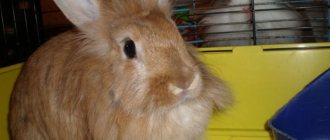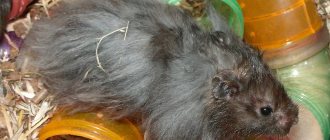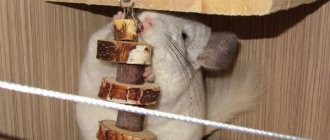Pet rats are intelligent and playful. They need a variety of toys to keep them happy and active. With a little creativity, you can create inexpensive and fun homemade toys to complement any store-bought toys.
Safety first
The most important thing when choosing a toy for a pet is its safety. Whatever you give your rat should be non-toxic; you should also be on the lookout for any pieces that may be swallowed and could cause a blockage in the digestive tract. Strands of fabric and rope can cause intestinal blockages, and loose threads can become tangled in the toes or create a choking hazard. Fleece toys are a good choice because they do not contain string or thread.
How to set up a play area for rats
Rats need space to play freely. Unlike other small rodents, they cannot stay in their cage for long. There are people who allow rats to roam around the house, but this is usually a bad idea. However, creating a safe area for your pet to play is the best way to keep rats entertained without damaging furniture in your home.
- Remove anything from the area that could harm rodents.
When creating a play area, make sure electrical wires are hidden. They can hurt your rat. Also clear the area of any toxic substances or sharps. Choose a place away from people and other animals.
The best place to place a rat entertainment area is in the corner of the room or on a wooden floor. The main thing is to arrange the area away from important things that can be easily chewed by animals, and away from electrical outlets.
- Place the blanket on a flat surface to protect it from damage.
It's best to plan the play area on a raised surface, but you can install it on the floor as well. Rats have an instinctive tendency to chew things, so it is worth covering the table or floor with a blanket to protect the surface.
If you set up a play area on a table, you won't have to build a fence around the area because rats won't jump from heights. Base your choice on your pet's personality to decide whether to keep them free or build a barrier.
Create an entertainment area on the floor for easier monitoring of your pets. However, rats may start chewing your carpet if they chew through your blanket.
- Cut and glue flat cardboard panels of the same size.
Take a few boxes, arrange them, and cut them until you are left with at least a few dozen pieces of the same size. Use duct tape to cover the holes and smooth out the folding parts so that each panel is completely flat. Then line up the panels side by side and tape the edges to form one long flexible barrier.
- Place a cardboard barrier around your chosen area in a circle.
Making sure the barrier is secured to the blanket, surround the area with cardboard in a circle shape until the two ends meet. Clamp the ends together and double-check for any holes that could allow rats to slip through. Then cover these holes with tape and you are ready to start adding toys.
Selecting materials
For a homemade wheel, natural materials are most suitable - thick plywood or chipboard. True, it is possible that after some time you will have to remake the “sports equipment”, because rodents tend to sharpen their teeth on everything that surrounds them. You will need: - plywood 6-10 mm thick or chipboard; - thin sticks of the same length - 40-60 pcs.; - thick wire for the axle; - small nails; - hammer; - saw or jigsaw; - paper for the template; - drawing tools.
Rat toys
There are many toys designed specifically for rats, such as:
- Wheels and balls.
Rat wheels are a great way for rodents to exercise and stay healthy. Be sure to choose a safe wheel that won't hit your rodent's legs or tail. Solid wheels are definitely preferable to wire mesh wheels. The optimal diameter for a rat wheel is 30 centimeters. It can be placed in a cage, as well as in a play area.
Small swords also support activity outside the cell. However, keep an eye on your pet when he is playing ball.
- Climbing toys.
Ladders, tubes, ropes, twigs, cement bird perches, hammocks and similar devices can provide numerous climbing activities for the animal. They are convenient to attach to the cage, but they are also great for the playground.
- Chew toys.
Rodents need toys that they can use to chew. They are needed to keep rats' teeth healthy as they grow and need to be worn down. Quality chew toys are made from rawhide, wood (no preservatives), or cardboard. Toilet paper cardboard, cardboard boxes, and egg cartons make great affordable rat teeth grinding toys.
Wheels are different
The diameter of the wheel depends mainly on the size of the animal and the length of its stride. Of course, the wheel for a Djungarian hamster will be smaller than for a squirrel or chipmunk. A wheel that is too large will be difficult for the animal to rotate, and too wide gaps between the bars can lead to injury. Therefore, even before choosing a material, figure out what size wheel you need. For a squirrel or chipmunk its diameter will be approximately 40 cm, for a Syrian hamster 20 cm is enough.
Water activities for rats
Pea fishing is a great water game for rats. Place a cloth in the entertainment area, then take a bag of frozen peas and place a handful in a shallow ceramic or glass bowl of cool water. Add some large, smooth rocks for your rat to climb on. Show the rats their new pool. Now you can watch them jump into the water and dive for peas, or sit on the edge playing with the peas with their front paws, or just lie in the water and eat the peas they retrieved.
Your water-loving rats will love the opportunity to swim and snack at the same time. And those who are afraid of water will be able to sit calmly on a rock or on the edge of a pool and catch peas floating by.
How to please your pet?
From such an abundance of materials you can create a large number of different toys and fun products; this is not a complete list of materials, so the quantity and quality of products differs only by your imagination. It is very important at the design stage of the toy to take into account all factors so that the rodent not only likes it, but is also safe.
Ramps, ladders and ropes are fun alternatives to regular cage slides
The rat is one of the most intelligent animals, so it cannot sit in one place, it needs to constantly do something. Then the pet will feel good, is in excellent shape and will confidently communicate with its owner. There are several models of different products, each of which is unique and fun in its own way. Let's look at the instructions for creating the best toys for rats.
Digging container
Previously, we looked at the features of this product, but we should consider in more detail the stages of creating a toy, because we need to take into account some features. Such a box can keep a rat occupied for several hours, and it brings the animal closest to its natural conditions. In addition, the rodent will not only be able to dig, but will also consume roots, grass and sprouted seeds. In the summer, the pet will be able to spend time in cool ditches, which he himself will make in this box. To create a product, you should perform the following algorithm of actions:
- You need to prepare a fairly large box; it is best to choose an eraser product, for example, a kitchen bowl.
- The box is half filled with clean soil.
- You should throw grain or birdseed into the soil, then water it with a small amount of water.
- Within a few days, the seeds will germinate, and after 7 days the harvest will be enviable.
- You need to place the box in a place where it can be easily removed.
- After this, you can put the rat in this box.
Article on the topic: Is it possible to wash a rat: instructions for bathing decorative rats at home
At first, the rodent will not understand what it needs to do, and will also be embarrassed to cause mischief, casting doubtful glances at the owner.
Soft tunnel
This is a very simple and easy to implement product, but you will still need to have basic knowledge and sewing skills. To implement a soft tunnel, you should perform the following algorithm of actions:
- It is necessary to prepare a piece of inexpensive fabric, for example, cotton or fleece.
- We cut out a piece from this material, the size of which is 35 centimeters in width and 1.5 centimeters in length; you do not need to strictly adhere to this size, focus on the dimensions of the finished product.
- Next, you need to proceed directly to creating a tunnel. A sewing machine is perfect for these purposes, although you can also use the manual method, although it will take a lot of time.
- If you have the appropriate skills, then you can add several more to one tunnel, as well as make separate rooms and all kinds of branches.
- Rings are cut out of a plastic bottle, which need to be secured at the ends of the tunnel, and if it is long, then in the middle. Thanks to such actions, the product will always be open.
Pets will love this toy; they will wander through the tunnel and hide if necessary. This product is able to imitate the natural habitat of rodents, because they always build a whole cold system underground. Making toys for rats with your own hands is not that difficult, the main thing is to show patience, responsibility and creativity.
Maze for rats
You can build the following types of labyrinths:
- A labyrinth of pipes.
Fabric tubes are ideal for creating complex mazes for your rats. Go to your local hardware store for a variety of PVC pipes that are at least 2 inches wide. Connect corner pipes, straight pipes, and their connectors in any order to create a tunnel maze. You can also make fabric tunnels by cutting off the legs or sleeves of old clothes and stuffing them with toilet paper tubes.
However, PVC ones are better for rats that like to chew a lot, while a fabric tunnel allows you to keep an eye on where your rat is in the maze.
Simply separate the fabric tubes from each other when you are ready to remove the play area. You can create a different kind of maze the next time you release the rats.
- Labyrinth of boxes.
Rats love to climb and climb, so you can stack boxes to create a maze. But the structure must be strong enough to climb without collapsing under the weight of your rats. If you're feeling ambitious, try training your rat to jump through hoops, ramps, and other openings.
Use treats or moving objects to guide her through a route or maze. Rats will instinctively chase anything that moves quickly, so use string, feathers, or small crushed balls.
PROJECT MYSHKO - assembly instructions
For work we will need a lot of empty plastic bottles. Their number depends on the desired size of the future labyrinth. More bottles - a longer and more confusing labyrinth. You also need scissors, a sharp knife, a marker, tape or glue may come in handy.
Now we begin to create the first working module of our ultra-modern cybernetic mouse lair. To do this, draw two circles on one of the bottles, along which we will then cut out the gateway.
You should get two circles: a large one and a small one. Another bottle should subsequently fit into the large circle, and only the neck of this bottle should come out through the small circle on the other side. Be sure to take these dimensions into account when designing the airlock (I was estimating with my bulbous naval eye, but experienced engineers can use a caliper or a simple ruler).
When the graphic constructions are completed and carefully verified, you can cut out the holes using a knife and scissors. ATTENTION! BE CAREFUL, THE PLASTIC OF THE BOTTLE IS QUITE FICIOUS WHEN CUT OUT, YOU CAN GET CUT VERY EASILY.
On the other bottle you just need to cut a small hole (so your rodent can fit through it).
Now we connect two bottles, as shown in the figure.
Just like that, we got the finished node of our labyrinth.
The cap can be screwed on if it improves the hold of the bottles. But usually they hold up well anyway, thanks to the ring at the neck, which was originally intended for more convenient transportation.
If you still can’t figure out how the rodent will move in this block, then look at the view from the inside. The inner bottle is turned with a hole towards the longitudinal axis of the second bottle, so your pet can easily crawl from one bottle to another.
Then you can complete the labyrinth yourself, attaching bottles to each other by analogy. If cold and sober calculation cannot keep up with your wild imagination and something doesn’t hold well or even falls off, then tape or glue can easily solve the problem. This is the project I came up with:
Let me clarify a few points about the labyrinth. This concept is suitable for any mice, rats or hamsters. They will get through, don't be afraid. In nature, these rodents dig even narrower holes for themselves. I can't vouch for the guinea pigs alone. The likelihood that a rodent will injure itself on the unevenly cut edge of a bottle is practically zero. Nature took good care of the vitality of these animals. It is also impossible to suffocate inside the structure, unless, of course, you decide to completely seal it. To be on the safe side, do not leave your pets unattended in the maze. A rat, for example, can chew through glass or even concrete.
Perhaps that's enough theory, let's move on to practice











